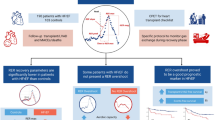Abstract
Circulation time (the transit time for a bolus of blood through the circulatory system) is a potential index of cardiac dysfunction in chronic heart failure (HF). In healthy subjects, circulation time falls as cardiac output (Q) rises during exercise, however little is known about this index in HF. In this study we examined the relationship between lung-to-lung circulation time (LLCT) during exercise in ten HF (53 ± 14 year, resting ejection fraction = 23 ± 8%) and control subjects (51 ± 18 year). We hypothesized that HF patients would have slower LLCT times during exercise when compared to control subjects. Each subject completed two identical incremental exercise tests during which LLCT was measured in one test and Q measured in the other. Q was measured using the open circuit C2H2 washin technique and circulation time measured using an inert gas technique. In HF patients and control subjects, LLCT decreased and Q increased from rest (HF:LLCT = 53.6 ± 8.2 s, Q = 4.3 ± 1.1 l min−1; control: LLCT = 55.3 ± 10.9 s, Q = 4.5 ± 0.5 l min−1) to peak exercise (HF:LLCT = 20.6 ± 3.9* s, Q = 8.8 ± 2.5* l min−1; control:LLCT = 14.9 ± 2.4 s, Q = 16.5 ± 1.2 l min−1; *P < 0.05 vs control). LLCT was significantly (P < 0.05) slower for the HF group when compared to the control group during submaximal exercise and at peak exercise. However, at a fixed Q the HF subjects had a faster LLCT. We hypothesize that the faster LLCT at a fixed Q for HF patients, may be the result of a more intensive peripheral vasoconstriction of non-active beds and a better redistribution of blood flow.




Similar content being viewed by others
References
Andreas S (2000) Central sleep apnea and chronic heart failure. Sleep 23(Suppl 4):S220–S223
Caples SM, Wolk R, Somers VK (2005) Influence of cardiac function and failure on sleep-disordered breathing: evidence for a causative role. J Appl Physiol 99:2433–2439. doi:10.1152/japplphysiol.00676.2005
Hall MJ, Xie A, Rutherford R, Ando S, Floras JS, Bradley TD (1996) Cycle length of periodic breathing in patients with and without heart failure. Am J Respir Crit Care Med 154:376–381
Johnson BD, Beck KC, Proctor DN, Miller J, Dietz NM, Joyner MJ (2000) Cardiac output during exercise by the open circuit acetylene washin method: comparison with direct Fick. J Appl Physiol 88:1650–1658. doi:10.1063/1.373866
Joyner MJ (2004) Congestive heart failure: more bad news from exercising muscle? Circulation 110:2978–2979. doi:10.1161/01.CIR.0000148051.30882.6B
Lanfranchi PA, Braghiroli A, Bosimini E, Mazzuero G, Colombo R, Donner CF, Giannuzzi P (1999) Prognostic value of nocturnal Cheyne-Stokes respiration in chronic heart failure. Circulation 99:1435–1440
Middlekauff HR, Nitzsche EU, Hoh CK, Hamilton MA, Fonarow GC, Hage A, Moriguchi JD (2001) Exaggerated muscle mechanoreflex control of reflex renal vasoconstriction in heart failure. J Appl Physiol 90:1714–1719
Momen A, Bower D, Boehmer J, Kunselman AR, Leuenberger UA, Sinoway LI (2004) Renal blood flow in heart failure patients during exercise. Am J Physiol Heart Circ Physiol 287:H2834–H2839. doi:10.1152/ajpheart.00394.2004
Morris NR, Snyder EM, Beck KC, Haseler LJ, Olson LJ, Johnson BD (2007) The relationship between resting lung-to-lung circulation time and peak exercise capacity in chronic heart failure patients. J Card Fail 13:389–394. doi:10.1016/j.cardfail.2007.02.002
Rowell LB (1993a) Circulatory adjustments to dynamic exercise and heat stress: competing controls. In: Rowell LB (ed) Human cardiovascular control. Oxford University Press, Oxford, pp 363–406
Rowell LB (1993b) Human cardiovascular control. Oxford University Press, Oxford
Sinoway LI, Li J (2005) A perspective on the muscle reflex: implications for congestive heart failure. J Appl Physiol 99:5–22. doi:10.1152/japplphysiol.01405.2004
Sowton E, Bloomfield D, Jones NL, Higgs BE, Campbell EJ (1968) Recirculation time during exercise. Cardiovasc Res 2:341–345. doi:10.1093/cvr/2.4.341
Sullivan MJ, Knight JD, Higginbotham MB, Cobb FR (1989) Relation between central and peripheral hemodynamics during exercise in patients with chronic heart failure. Muscle blood flow is reduced with maintenance of arterial perfusion pressure. Circulation 80:769–781
Triebwasser JH, Johnson RLJ, Burpo RP, Campbell JC, Reardon WC, Blomqvist CG (1977) Noninvasive determination of cardiac output by a modified acetylene rebreathing procedure utilizing mass spectrometer measurements. Aviat Space Environ Med 48:203–209
Vanhoutte PM (1996) Endothelium-dependent responses and inhibition of angiotensin-converting enzyme. Clin Exp Pharmacol Physiol 23:S23–S29. doi:10.1111/j.1440-1681.1996.tb03037.x
Wolff CB, Checkley SK, Bhageerutty G, Bhatt H, Johnston A, Collier DJ, Tachtsidis I, Garvie N, Rosenberg ME, Benjamin N (2005) Circulation time in man from lung to periphery as an indirect index of cardiac output. Adv Exp Med Biol 566:311–316. doi:10.1007/0-387-26206-7_41
Yamabe H, Itoh K, Yasaka Y, Takata T, Yokoyama M (1995) The role of cardiac output response in blood flow distribution during exercise in patients with chronic heart failure. Eur Heart J 16:951–960
Acknowledgments
The authors of this study would like to thank Kathy O’Malley and Angela Heydmann for their assistance in the data collection and management of this project. This work was supported in part by National Institute of Health grant HL71478, the Heart Foundation Research Centre and Griffith University.
Author information
Authors and Affiliations
Corresponding author
Rights and permissions
About this article
Cite this article
Morris, N.R., Snyder, E.M., Beck, K.C. et al. Lung-to-lung circulation times during exercise in heart failure. Eur J Appl Physiol 106, 621–627 (2009). https://doi.org/10.1007/s00421-009-1051-4
Accepted:
Published:
Issue Date:
DOI: https://doi.org/10.1007/s00421-009-1051-4




